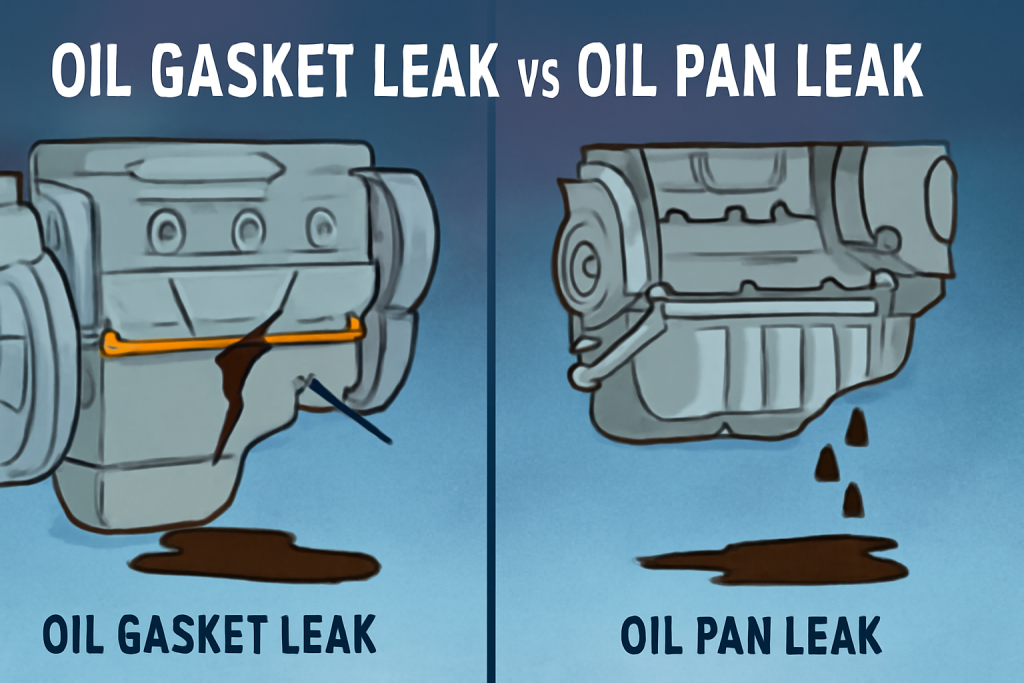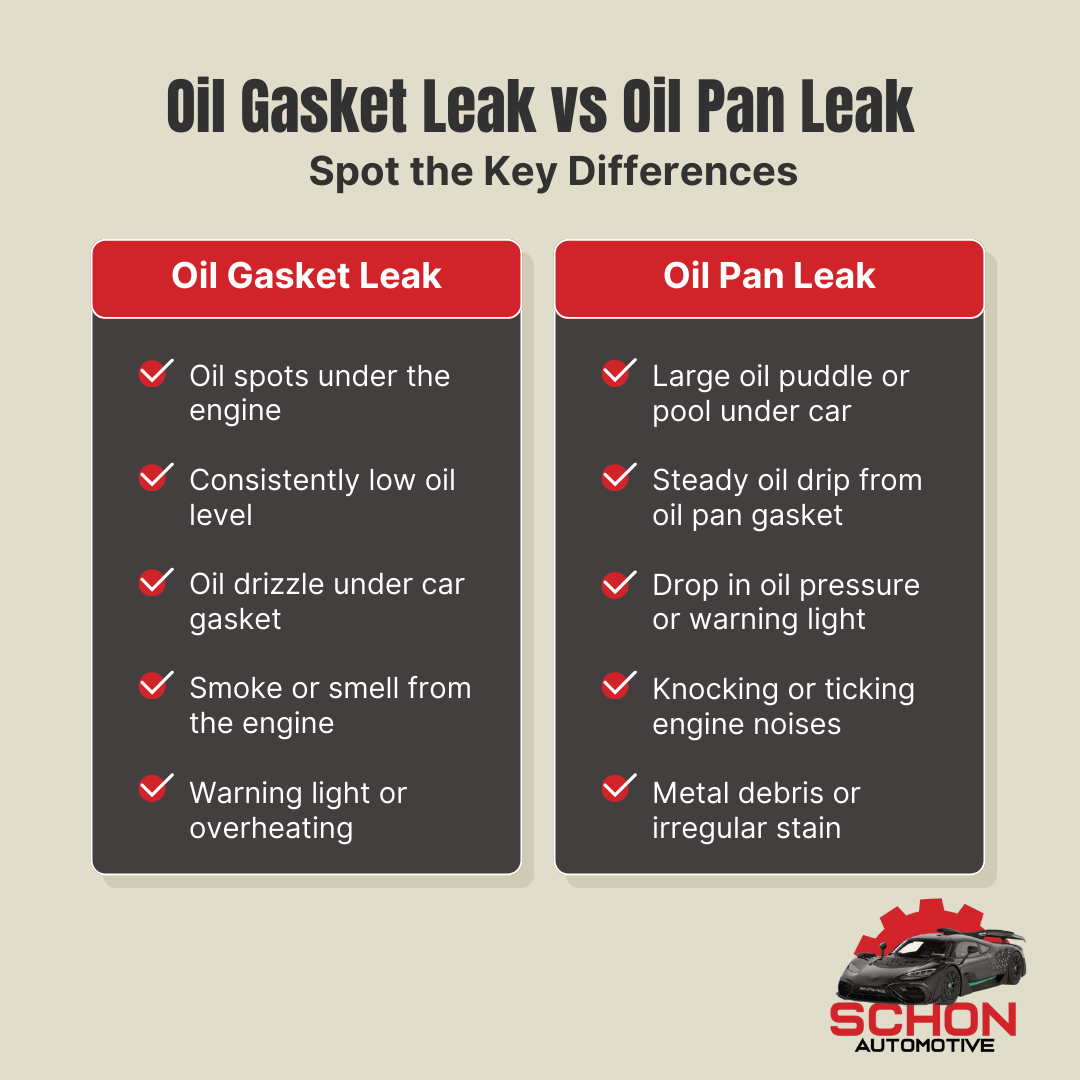How to Spot an Oil Gasket Leak vs Oil Pan Leak & What to Do?

When the car leaves a few drops of oil on the driveway, driver just brush it off. They think, “It’s just a small drip, nothing major.” But oil leaks are never a harmless drip. They’re the first warning sign of a serious issue hiding under your bonnet.
Two common culprits in this regard are oil pan leak & oil gasket leak. They are difficult to diagnose because of similar symptoms & novice drivers can’t identify the root of problem.
At Schon Automotive, we’ve repaired countless cars across Perth where a “tiny oil drip” turned into a cracked engine block, seized pistons, or burnt-out bearings. Our experience says that catching and fixing a leak early saves you thousands in repairs later.
That’s why, you should be aware that you’re dealing with an oil gasket leak vs oil pan leak. Let’s guide you about their differences, symptoms to watch for, and how we fix it.
What Is the Oil Pan?
The oil pan sits at the bottom of your engine, made up of stamped steel or aluminium.
It’s the reservoir where engine oil gathers before circulating. It screws onto the engine block with bolts and is sealed by the oil pan gasket. Its job: keep oil inside and safe from leaks.
The oil pan has a drain plug for oil changes. When its seal breaks or the pan cracks, and oil starts to drip. The pan’s location makes leaks easy to spot underneath the car. A pool of oil right under the engine points to this area.
At Schon Automotive, our technicians routinely inspect the oil pan during log-book car servicing. We check for cracks, loose bolts, and gasket sealing in the engine.
What Is the Oil Gasket?
When we say “oil gasket,” we mostly mean the oil pan gasket. It seals the joint between the pan and engine block, and made of rubber, silicone, or formed metal.
It must handle oil pressure, heat cycles, vibration and harsh chemical exposure. Due to these stress factors over time, the gasket dries, cracks, or compresses. So, the oil seeps out around the edges of the pan.
Unlike a cracked pan (which leaks heavily), gasket leaks start small. You’ll see only a drizzle, faint oil line, or slight wetness along the join. Our advanced diagnostics also include checking gasket condition during routine servicing & replacing it if needed.
Now, let’s discuss the difference oil gasket leak vs pan leak.
How to Tell an Oil Gasket Leak: Symptoms
Here’s how to spot oil pan gasket leak symptoms.
- Oil spots under the engine: small puddles or drips directly beneath the pan.
- Consistently low oil level: you need to top up oil more often than usual.
- Oil drizzle under car gasket or pan leak: you’ll see a thin line or wet streak leading down.
- Smoke or smell: oil drip onto hot parts, causing faint black smoke from under the hood.
- Warning light or overheating: low oil causes friction and heat build-up.
These clues can help you in oil gasket or pan leak how to tell without guesswork.
How to Tell an Oil Pan Leak: Symptoms
It also shows similar signs, but there are a few extras you should watch out to spot oil pan leak vs gasket leak.
Here are identifying symptoms of oil pan leak.
- Large oil puddle or pool under car gasket leak? bigger leak area, darker and wider.
- Oil drip from oil pan gasket: Steady, visible drips directly under the pan.
- Drop in oil pressure or warning light: engine isn’t holding pressure due to oil loss.
- Knocking or ticking engine noises: caused by low oil, especially with a cracked oil pan.
- If the pan is cracked: occasional metal debris or irregular stain patterns will show.
A quick comparison of oil leak detection gasket vs oil pan is given as:
Diagnosing Pan vs Gasket Leak Without Pulling the Engine Apart
You don’t need to take the engine apart to nail down the source. We can diagnose an oil leak diagnosis gasket vs pan though a simple procedure.
- Clean the engine and underside and wipe everything dry.
- Run the engine, then check oil paths with a flashlight.
- Use UV dye to engine oil, run, and shine UV light to trace the leak.
- Look where the oil collects. If it drips straight down from the pan edges, it’s the oil pan or gasket.
- Check other suspects, as valve cover, rear main seal, or crankshaft seal can also leak, & run oil down the block.
- Observe oil pool shape. A smear across the underside means the leak is higher up.
Our auto diagnostics tools make these checks fast and accurate. We confirm the leak’s origin before we recommend a repair. That diagram tells you to “start at the top and work your way down”, so, you avoid misdiagnosis.
Repair Options & Costs: Gasket vs Oil Pan Replacement
Once you’ve diagnosed the problem, it’s time for fixes. So, let’s compare gasket vs oil pan replacement repairs and guide you on what you can do.
Oil Pan Gasket Replacement
- Remove oil pan, clean mating surfaces.
- Install new gasket, torque bolts correctly.
- Replace oil and filter.
- Cost at mechanic is generally moderate.
- DIY can also do it, but only if you have practice.
- Quick & tight seals will get your engine safe again.
Oil Pan Replacement (if cracked or warped)
- Remove old pan, possibly sealant.
- Fit new pan, use correct gasket/material.
- Replace oil and filter.
- Cost is higher, from $400–$1,200, depending on damage & labour.
- Only needed when pan is bent or cracked.
Rear Main Seal or Crankshaft Seal vs Pan Gasket Leak
- RMS will drip from the rear and oil spreads differently.
- Its diagnosis will require transmission removal and high labour.
Get more Details at How to Fix Engine Oil Leaks? A Guide to Car Oil Leak Repair
If you are confused in the procedure, come to us. Our experienced technicians can get it done fast, during a single visit.
Preventing Future Oil Leaks: Maintenance Tips from Experts
Stopping leaks before they start is always better than fixing them. Remember these tips from expert mechanics to prevent oil gasket and pan leaks.
Tips | Details |
Regular log book servicing | we follow manufacturer guidelines to keep gaskets healthy |
Torque check on oil pan bolts | loose bolts are a common cause |
Use correct drain plug and gasket | wrong plugs or washers can cause leaks |
Avoid double gasket when changing filter | clean old gasket off before installing new filter |
Inspect during oil changes | we quickly spot leaks starting to appear |
Drive carefully | potholes and rough roads may damage or warp your oil pan |
Our log book servicing keeps your car well-maintained. So, you can prevent oil leak issues before they cause trouble.
When to Call a Mechanic? And How Early Repairs Save You Money
You should see a mechanic if:
- Oil is persistently low.
- You notice drips or puddles under your car.
- Smoke or smell from under hood.
- Engine noise or warning lights.
But remember to do it ASAP because leaving a leak unchecked can lead to:
- Worsening leak and bigger repair cost.
- Engine wear, overheating, or damage.
- Risk of fire, environmental mess, or being stuck roadside.
Early care means cheaper fixes. That’s why, we offer fast service, thorough vehicle inspection, and open quotes to help Perth drivers get back on the road safely.
Are You Noticing Oil Drizzle Under Car Gasket or Pan Leak?
Schon Automotive: Your Trusted Partner in Oil Leak Repairs
At Schon Automotive, we help you spot the oil gasket leak vs oil pan leak. Our friendly team will guide you on clear & simple signs to detect the damage. E.g. a valve cover oil leak vs pan leak or oil pool under car gasket leak.
Our services include:
Advanced Diagnostics | We find the leak fast and accurately |
Experienced Technicians | Nothing goes unchecked from their expert eye |
Transparent Pricing | No surprises or bargaining, just honest quotes |
Fast & Friendly Service | We respect your time and your car |
Comprehensive Repairs | Be it engine, brakes, transmission, or suspension |
Commitment to Quality | Every job, no matter small or big, is done with care |
Servicing Every Make & Model | Toyota, Ford, Honda, Mercedes, Range Rover, BMW, and more |
So, if you are dealing with the crankshaft seal vs oil pan leak, or that rear main seal vs pan gasket leak, come to us. We’ll guide you through diagnosis, costs, and repair options.
So, you can keep your engine healthy & get safely back on the road.

